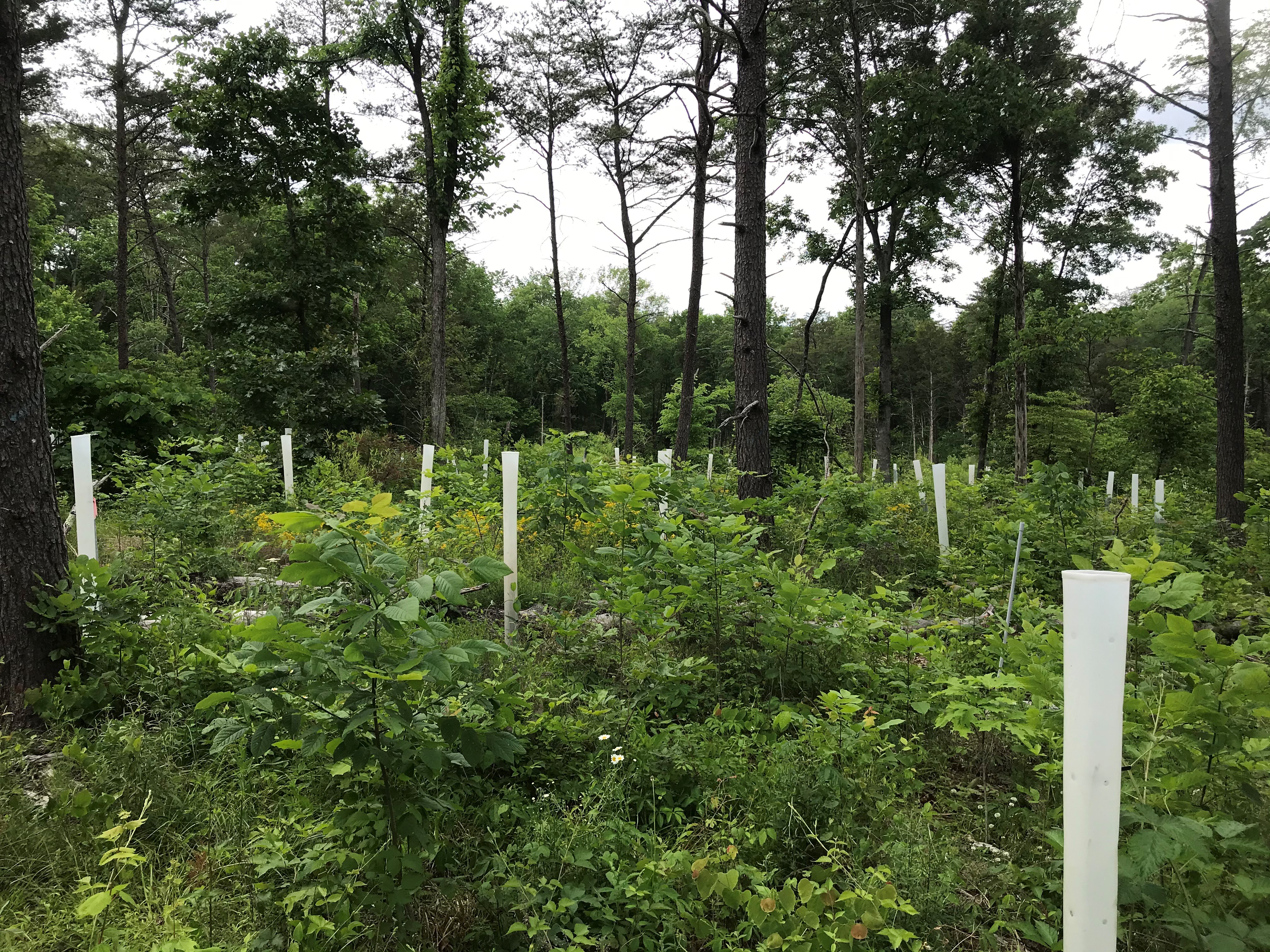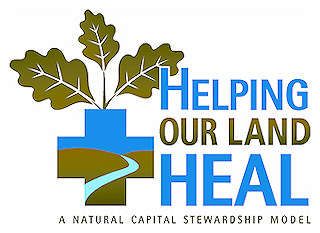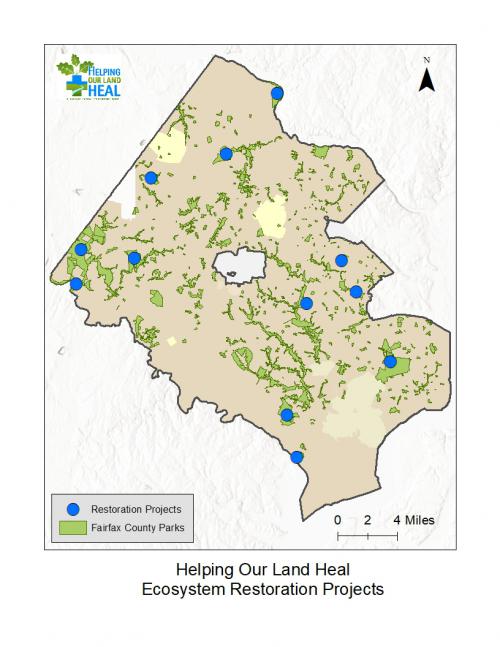Alert:

 The Park Authority has a program to restore natural areas on park lands called Helping Our Land Heal. Helping Our Land Heal rebuilds, restores, enhances and maintains quality natural areas.
The Park Authority has a program to restore natural areas on park lands called Helping Our Land Heal. Helping Our Land Heal rebuilds, restores, enhances and maintains quality natural areas.
Work is conducted on several Helping Our Land Heal projects each year. The first project was a pilot study completed in 2015 at Ellanor C. Lawrence Park in Chantilly. The Natural Resources Branch is a part of the Park Authority's Planning and Stewardship Division that oversees these projects.
 The Helping Our Land Heal Program includes 30 projects on 300 acres at 15 different parks. 16 projects are in the installation phase and 13 installations have been completed as of September 2024. After installation, on-going maintenance is required to keep these project areas in healthy condition, which will be provided by Landscape Legacy program within Natural Resources Branch.
The Helping Our Land Heal Program includes 30 projects on 300 acres at 15 different parks. 16 projects are in the installation phase and 13 installations have been completed as of September 2024. After installation, on-going maintenance is required to keep these project areas in healthy condition, which will be provided by Landscape Legacy program within Natural Resources Branch.
The map below shows the locations of Helping Our Land Heal ecosystem restoration projects and a description of each project follows.

Poplar Ford Park is a 439-acre park in Centreville, VA. Poplar Ford contains upland forest, floodplain forest and large meadows. The park is one of the few in Fairfax County with meadows extensive enough to support grassland birds. The restoration project restored 44 acres of degraded meadow to high-quality native grassland and enhanced 25 acres of existing shrubland and wet meadow habitat. Increasing habitat size and quality for native grassland birds was a major project goal. Restoration methods include removing invasive species, removing thickets of invasive shrubs and red cedar, prescribed burns, soil nutrient restoration, and seeding native grassland plants. This project was active from 2015-2018, and FCPA's Natural Resources Branch earned a 2019 FCPA Trailblazers Award for environmental stewardship. Additionally, 8 acres of successional red cedar forest were restored to high-quality native grassland from 2020-2023, expending bird grassland bird habitat to 52 acres in total.
From 2012-2015, ecological restoration and natural resource management work was conducted at Ellanor C. Lawrence Park as a pilot study. The project goals were
Field investigations informed the development and implementation of two written resource management plans. More than 20 hands-on restoration practices were implemented at the park. Among the methods used were nine types of forestry treatments, three strategies of non-native invasive plant control, two methods of deer management, four soil treatments, and two methods of natural disturbance regime re-introduction.
Fitzhugh Park is 10-acre forested park within a heavily urbanized area in Annandale, VA. Most of the park is forested, dominated by species typical of mixed-mesic forests such as tulip poplar, American beech, white oak, and red oak. Fitzhugh also contains a small floodplain forest community and a small meadow. Forest fragmentation, urban stormwater runoff, deer overabundance, invasive species and illegal trash dumping have degraded several acres of the park’s forest. The restoration project began in 2017 and aimed to restore Fitzhugh Park’s degraded forest and meadow. Upon project completion in 2020, significant ecological improvements had been made. The meadow restoration area, which had initially been choked by invasive shrubs and vines, now contains a diverse and colorful assortment of native grasses and wildflowers. Invasive species were removed throughout the forest restoration area and replaced with oak trees and a variety of native shrubs, which will ensure that the forest remains healthy and productive for years to come.
White Gardens is a 13.6-acre park in Falls Church. Previous owners cultivated an expansive garden landscape throughout the property under the shade of a mature tree canopy. A three-acre open field was retained and mowed as a large lawn. A meadow restoration project began in 2015 to restore this field to a diverse native plant grassland community. Upon its completion in 2018, the meadow contained numerous, colorful, native grass and wildflower species supporting native pollinator and bird species. In 2019, the project won an award for Best New Environmental Sustainability from the Virginia Recreation and Parks Society.
Riverbend Park is a 400-acre park on the Potomac River in Great Falls, VA. Riverbend contains mature upland forest, high-quality floodplain forest, and several meadows that are popular with birdwatchers. When the restoration project began in 2018, these meadows were dominated by invasive pasture grasses and had low diversity of native plants. The restoration project aimed to remove invasive plants, increase native plant diversity, and increase diversity of pollinator floral resources on four acres of meadow. Restoration methods included invasive species removal, planting native shrubs, and seeding native grassland plants using a no-till seed drill. Upon successful project completion in 2020, the meadows were rich with a diverse and colorful assortment of native grasses and wildflowers, providing high-quality habitat for insects, birds, and other wildlife. Healthy meadow habitat will be maintained with periodic mowing and prescribed burns.
Elklick Preserve is a 1,400-acre park in Centreville, VA. The park contains a mosaic of young Virginia pine forest, mature oak-hickory forest, and grassland. Elklick Preserve is home to one of Virginia’s highest-quality examples of a Northern Hardpan Basic Oak-Hickory Forest, a rare forest type that occurs only on fertile, shrink-swell clay soils. The forest restoration project began in 2017 and aimed to restore 23 acres of degraded forest to high-quality Northern Hardpan Basic Oak-Hickory Forest. Restoration methods included thinning Virginia pine, removing invasive plants, planting native oak and hickory seedlings, and deer exclusion fencing. Planting of appropriate oak and hickory seedlings occurred during 2020/2021 seasons and young, well stocked, forest is on trajectory to become high-quality Northern Hardpan Basic Oak-Hickory Forest. The project was recognized as successful by USDA Department of Forestry and was presented on multiple conferences as an example of oak forest regeneration.
Elklick Preserve’s 1400 acres contain a 60-acre grassland, or meadow, that is being restored with the goal of providing breeding habitat for declining grassland bird species such as eastern meadowlarks and grasshopper sparrows. These birds carefully choose their nesting habitat and restoration of the grassland will allow the Park Authority to manage it for their requirements. The restoration was needed because trees and non-native invasive plants have invaded the meadows and made them inhospitable to grassland birds. In addition, the grassland restoration aims to strengthen local populations of rare plants that are not secure because of human uses of their habitat such as utility line repairs and improvements. Both of these goals required the intensive control of non-native invasive plant species using a variety of tools, including prescribed burn, seeding, and planting of native grasses and forbs where thickets of young trees and shrubs have been removed. This project began in 2018 and was concluded in 2023 by creation of 60 acres of high-quality grassland.
Old Colchester Park and Preserve is a 140-acre park near the mouth of the Occoquan River in Lorton, VA. The park is primarily forested with a patchwork of upland forest, floodplain forest, depression swamps, and seepage swamps. A Natural Resources Management Plan (NRMP) was completed for Old Colchester in 2011, and implementation of management recommendations began in 2012. Management goals included restoration of degraded upland forest, protection of high-quality forested wetlands, and restoration of hydrology in degraded rare wetlands. Restoration methods included removing invasive species, planting native trees, seeding native grasses and wildflowers, prescribed fire, deer protection, and plugging human-made drainage ditches to restore proper hydrology. The work on these two projects was conducted between 2018 and 2023.
Ellanor C. Lawrence Park is a 650-acre, resource-based park in Chantilly, VA. The park is divided in two parts by Route 28. The west side of the park is developed as a recreational area with forest remnants surrounding athletic fields. The core of the park, east of Route 28, is mainly forested with a mosaic of relatively young forests. Forest fragmentation, a high deer population, and non-native invasive species infestations have degraded many acres of forest in the park. The goal of the forest restoration is to create Acidic Oak Hickory and related forest types where the existing unhealthy forest will lead to further degradation and forest loss. Planned restoration activities include deer exclusion, silvicultural treatments, control of invasive species, and increasing native plant biodiversity by planting and seeding. This project began in 2019.
Frying Pan Farm Park is in Herndon, VA. The park is 135 acres in size, including 70 acres of undeveloped natural area. Frying Pan contains nature trails and a working farm and is one of the most popular and highly visited parks in Fairfax County. Frying Pan is also home to a Northern Hardpan Basic Oak-Hickory Forest, a rare forest type that only occurs on fertile, shrink-swell clay soils. The forest restoration project began in 2019 and aims to restore 16 acres of degraded forest to high-quality oak-hickory forest. Restoration methods include thinning unhealthy and undesirable tree species, removing invasive plants, deer exclusion fencing, and planting native oak seedlings. In addition to ecological restoration goals, this project also aims to involve the local community through volunteer opportunities and educational programs. The Friends of Frying Pan Farm Park has provided generous financial and logistical support for this project.
Green Spring Gardens is a 31-acre park in Lincolnia, VA that contains a variety of gardens, horticultural displays, and natural areas. Green Spring is home to an extremely rare Northern Coastal Plain Terrace Gravel Bog. These bogs, characterized by gravelly substrate and an abundance of sweetbay magnolia, exist along the fall line of the Mid-Atlantic Coastal Plain Urbanization and other land use changes have all but eliminated these bogs from the landscape. The bog at Green Spring Gardens is one of the very few remaining, and it is threatened by erosion from stormwater runoff and non-native invasive plant species. This restoration project began in 2021, and aims to remove invasive species, promote native biodiversity through natural regeneration, and prevent negative impacts of erosion.
Green Spring Gardens is a 31-acre park in Lincolnia, VA that contains a variety of gardens, horticultural displays, and natural areas. The Natural Resource Branch will work at Green Spring Gardens to restore 0.25 acres of overgrown lawn to a native plant dominated meadow ecosystem. The restored meadow will provide habitat for pollinators, will prevent non-native invasive plants from spreading, and promote biodiversity. Additionally, it will increase the variety of wildlife habitat within the park. Restoration methods include removing invasive species, mowing, and seeding native grassland species by hand broadcasting seed. The project began in 2021.
Huntley Meadows Park contains over 1500 acres of natural area including a large wetland ecosystem that was restored in 2014. A new project started in 2021 on a much smaller scale to restore hydrology in drained forested wetlands in the interior of the park. Human-made drainage ditches lowered the water table in these forests and facilitated agriculture and other uses. As a result, a matrix of rare wetland forests was reduced in size and some were lost all together. When agriculture and other uses were abandoned, the vegetation that returned was adapted for dryer conditions and became badly invaded with non-native invasive plants. The rare wetland forests are called Coastal Plain Upland Depression Swamps and occur on isolated land depressions over clay soils that hold water for extended periods of time each year. Plugging these ditches with soil will raise the water table to simulate natural conditions and will shift the vegetation back towards a more natural condition.
LLake Fairfax is a 460-acre park in Reston, VA that hosts a 20 acre lake surrounded by forested natural areas and developed active recreational facilities, as well as a small meadow area. The meadow area is infested by non-native invasive (NNI) plants, such as mugwort, and shrubs, such as autumn olive, that provide very little benefit to wildlife and pollinator species. The goal of the restoration project is to restore the 2 acre meadow to a native plant dominated ecosystem that will support wildlife and pollinators with native wildflowers and grasses. Restoration methods include removing invasive species, prescribed burns, soil nutrient restoration, and seeding native grassland species with a no-till seed drill. The project began in 2021.
Laurel Hill Park is a 1,200-acre park complex in a medium-density residential area in Lorton, VA. Forested areas are at the northern part of the park, while the southern part is primarily recently abandoned agricultural land, much of which was part of the Lorton Prison system before the Park Authority acquired the land. The majority of the park is characterized by undeveloped open space, in most cases overgrown by non-native invasive plants. A forest restoration project began in 2019 at a site on abandoned agricultural land that was overgrown by kudzu, mugwort, and other invasive species. It is near Lorton Road and the Fairfax Cross County Trail. The goal of the restoration is to eliminate invasive species from the site and establish a healthy Piedmont acidic oak-hickory forest. The focus of the restoration work is on invasive plant control and removal, deer exclusion, and increasing biodiversity by planting and seeding native plant species.
Laurel Hill Park is a 1,200-acre park complex in a medium-density residential area in Lorton, VA. The southern part of the park is primarily recently abandoned agricultural land, much of which was part of the Lorton Prison system before the Park Authority acquired the land. The majority of the park is characterized by undeveloped open space, in most cases overgrown by non-native invasive plants. A meadow restoration project began in 2022 at a site on abandoned agricultural land that was close to reclaimed landfill open grassland bird habitat. The restoration was needed because trees and non-native invasive plants have invaded the meadows and made them inhospitable to grassland birds. The intensive control of non-native invasive plant species using prescribed burn, mowing, seeding, and planting of native grasses and forbs where invasive species have been removed will be required to achieve the goal.
Old Colchester Park and Preserve is a 140-acre park near the mouth of the Occoquan River in Lorton, VA. The park is primarily forested with a patchwork of upland forest, floodplain forest, depression swamps, and seepage swamps. A Natural Resources Management Plan (NRMP) was completed for Old Colchester in 2011, and implementation of management recommendations began in 2012. Management goals include restoration of degraded upland forest, protection of high-quality forested wetlands, and restoration of hydrology in degraded rare wetlands. Restoration methods include removing invasive species, planting native trees, seeding native grasses and wildflowers, prescribed fire, and plugging human-made drainage ditches to restore proper hydrology. A new forest restoration of a five-acre section of the park was initiated in 2024. This new forest restoration will remove invasive species to allow natural regeneration of desired native tree species, such as willow oaks and red oaks.
Huntley Meadows Park contains over 1500 acres of natural area including a large wetland ecosystem that was restored in 2014. In addition to wetlands, large areas of the park are forested. As much of the land was once used for agriculture, hydrology was modified to the detriment of native plant species. The results are areas of the park that are badly invaded with undesirable species. Helping Our Land Heal has initiated a forest restoration covering about 9 acres in two sections of the park. One restoration unit is located along the southwest border of the park, and the other unit is located at the northern portion of the park off South Kings Highway. The forest restoration in Huntley Meadows Park seeks to change the trajectory of plant composition from invasive species to desired native plants. This goal will be attained by removing invasive plants, installing deer exclusion fencing, and planting preferred native plants. As a result, the ecosystem should shift to a more natural state over time.
Oakmont Park is a 135-acre park in Oakton, VA. The park is a mix of a golf course and driving range, recreation center, and forested natural areas. Many of the forests are in good condition, however there is a 9-acre section of park adjacent to Jermantown Road that was formerly used for agriculture and is currently badly degraded. The goal of this forest restoration will be to restore natural ecological processes and steer the areas toward Acidic Oak Hickory and Mixed Hardwood Forest types. Planned restoration activities include deer exclusion, silvicultural treatments, control of invasive species, and planting desired tree species in the degraded area.
Mason District Park is a 120-acre park in Annandale, VA. The park is a mix of ball fields, an amphitheater, and about 70 acres of forested natural areas. Many of the forests are in good condition, however there are small sections of park that are currently degraded and in need of ecological restoration. The degraded sections of the park are scattered throughout the central areas of the park, and total six acres. One restoration unit in the central eastern section of the park was once an open field and is now overgrown with invasive species. A section of the western part of the park has many large oak trees that have died due to oak decline. The goal of this forest restoration will be to restore natural ecological processes and guide the areas toward Mixed Oak/Heath and Mixed Hardwood Forest types via multiple techniques. Planned restoration activities include deer exclusion fencing, silvicultural treatments, control of invasive species, and planting desired tree species in the degraded areas.
